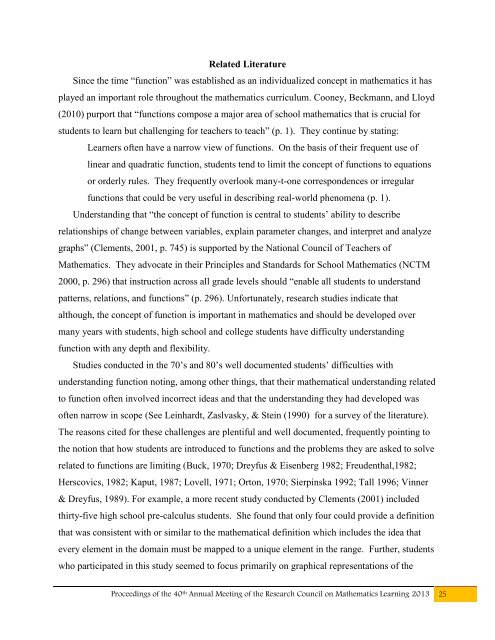2013 Conference Proceedings - University of Nevada, Las Vegas
2013 Conference Proceedings - University of Nevada, Las Vegas
2013 Conference Proceedings - University of Nevada, Las Vegas
- No tags were found...
Create successful ePaper yourself
Turn your PDF publications into a flip-book with our unique Google optimized e-Paper software.
Related LiteratureSince the time “function” was established as an individualized concept in mathematics it hasplayed an important role throughout the mathematics curriculum. Cooney, Beckmann, and Lloyd(2010) purport that “functions compose a major area <strong>of</strong> school mathematics that is crucial forstudents to learn but challenging for teachers to teach” (p. 1). They continue by stating:Learners <strong>of</strong>ten have a narrow view <strong>of</strong> functions. On the basis <strong>of</strong> their frequent use <strong>of</strong>linear and quadratic function, students tend to limit the concept <strong>of</strong> functions to equationsor orderly rules. They frequently overlook many-t-one correspondences or irregularfunctions that could be very useful in describing real-world phenomena (p. 1).Understanding that “the concept <strong>of</strong> function is central to students’ ability to describerelationships <strong>of</strong> change between variables, explain parameter changes, and interpret and analyzegraphs” (Clements, 2001, p. 745) is supported by the National Council <strong>of</strong> Teachers <strong>of</strong>Mathematics. They advocate in their Principles and Standards for School Mathematics (NCTM2000, p. 296) that instruction across all grade levels should “enable all students to understandpatterns, relations, and functions” (p. 296). Unfortunately, research studies indicate thatalthough, the concept <strong>of</strong> function is important in mathematics and should be developed overmany years with students, high school and college students have difficulty understandingfunction with any depth and flexibility.Studies conducted in the 70’s and 80’s well documented students’ difficulties withunderstanding function noting, among other things, that their mathematical understanding relatedto function <strong>of</strong>ten involved incorrect ideas and that the understanding they had developed was<strong>of</strong>ten narrow in scope (See Leinhardt, Zaslvasky, & Stein (1990) for a survey <strong>of</strong> the literature).The reasons cited for these challenges are plentiful and well documented, frequently pointing tothe notion that how students are introduced to functions and the problems they are asked to solverelated to functions are limiting (Buck, 1970; Dreyfus & Eisenberg 1982; Freudenthal,1982;Herscovics, 1982; Kaput, 1987; Lovell, 1971; Orton, 1970; Sierpinska 1992; Tall 1996; Vinner& Dreyfus, 1989). For example, a more recent study conducted by Clements (2001) includedthirty-five high school pre-calculus students. She found that only four could provide a definitionthat was consistent with or similar to the mathematical definition which includes the idea thatevery element in the domain must be mapped to a unique element in the range. Further, studentswho participated in this study seemed to focus primarily on graphical representations <strong>of</strong> the<strong>Proceedings</strong> <strong>of</strong> the 40 th Annual Meeting <strong>of</strong> the Research Council on Mathematics Learning <strong>2013</strong> 25




